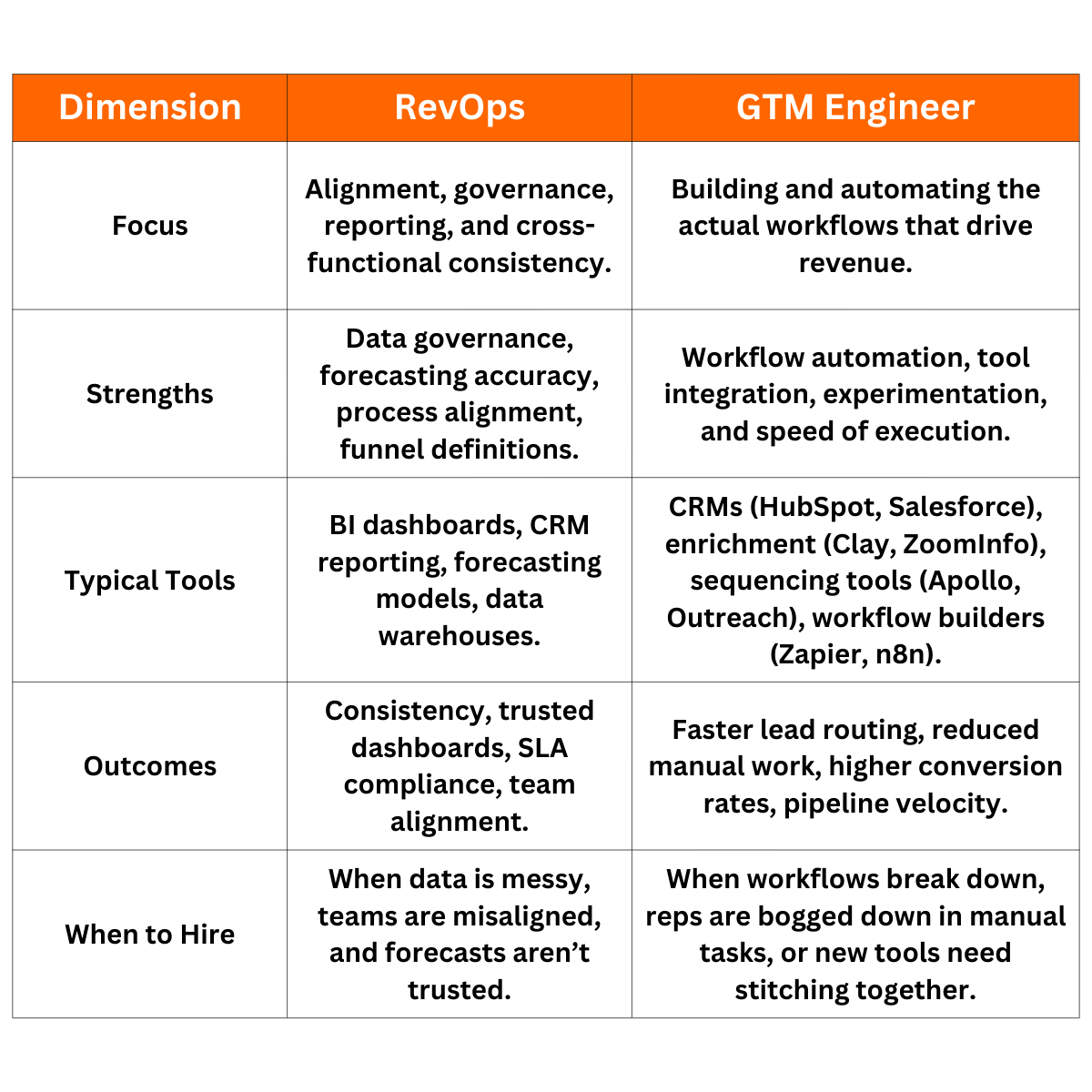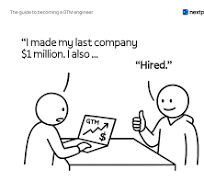Every startup eventually reaches the same inflection point: founder-led sales can’t carry the weight anymore.
Pipelines leak, tools don’t talk to each other, SDRs spend more time cleaning data than booking meetings, and marketing insists their leads are great while sales disagrees.
This is the chaos moment.
Historically, companies plugged this gap with RevOps or sales ops. But as GTM motions became more complex - multiple channels, enrichment tools, AI-powered signals - simply “aligning teams” wasn’t enough.
Startups needed someone who could design, connect, and automate the entire revenue system.
That’s the GTM Engineer.
Let’s dive in.
What is a GTM Engineer?
A GTM Engineer isn’t writing code. They’re engineering the sales and marketing engine that drives revenue.
Think of them as the bridge between strategy and execution. They take your ICP, your signals, and your revenue goals -then design the workflows, systems, and processes that actually make it all happen.
What they do:
→ Build and connect workflows across CRM, enrichment, and sequencing platforms.
→ Automate repetitive revenue tasks (lead routing, scoring, enrichment, reporting).
→ Validate and segment ICPs with data signals (funding, hiring, tech adoption).
→ Translate strategy into scalable, repeatable processes that sales and marketing teams run daily.
Without them, your funnel leaks. With them, the whole machine works in sync.
In 2025, GTM orchestration is about signal-based prospecting, revenue stack integration, and workflow automation - not just strategy.
Also Read - How to Build a Scalable GTM Engine Without Hiring a Full RevOps Team
Core Responsibilities of a GTM Engineer
In practice, a good GTM Engineer covers five areas:
→ System Design – Building repeatable workflows for outbound, inbound, and lead routing.
→ Process Automation – Connecting tools like HubSpot, Clay, Apollo, Outreach, Pipedrive.
→ Data Stewardship – Keeping your CRM clean, dashboards reliable, and reports meaningful.
→ Experimentation – Running ICP tests, message variations, channel experiments.
→ Enablement – Documenting playbooks so new hires plug in and ramp faster.
Key responsibilities include lead scoring automation, real-time lead enrichment, ICP experimentation, and automated routing rules - tasks that typically lift conversion rates by 10–15% when executed well.
💡 Startups with early RevOps/GTM ops hires see 15–20% faster pipeline velocity (OpenView).
When Should You Implement GTM Engineering?
Not every startup needs a GTM Engineer on day one. But there are clear signals that it’s time:
✅0–12 months: Stick to founder-led sales, simple CRM.
✅12–18 months: SDRs spend >20% of their week on manual list building. CAC starts to rise. CRM hygiene collapses.
✅18–24 months: Leads are leaking, channels are fragmented, reps complain about tool overload.
👉 “Hire your first GTM Engineer when founders spend more time fixing funnels than finding product-market fit.”

Steps to Implement GTM Engineering in Your Organization
Rolling out GTM Engineering isn’t about buying another tool – it’s about engineering the system that connects strategy to execution. Here’s a step-by-step framework:
1. Audit Current Workflows
Start by mapping the journey from lead capture → enrichment → routing → handoff → follow-up. Identify where things break:
Are SDRs spending hours cleaning CSVs?
Are inbound leads sitting idle in the CRM?
Do sales and marketing teams disagree on what a “qualified lead” is?
👉 A diagnostic exercise here will usually reveal at least 3–5 points of friction where automation or redesign can immediately free up time and reduce leakage.
2. Prioritize Quick Wins
Don’t try to boil the ocean. Tackle the highest-leverage fixes first:
Lead routing: Ensure new leads are instantly assigned to the right rep.
Enrichment: Automate data pulls (company size, tech stack, funding) so reps don’t waste time researching.
Scoring: Implement a simple model (ICP fit + intent + engagement) to prioritize follow-ups.
These small wins often reclaim 8–12 hours per rep per week and dramatically improve speed-to-lead.
3. Map the Stack for Orchestration
Most teams already have a CRM, a sequencer, and enrichment tools – but they rarely talk to each other cleanly.
Document how data flows between systems.
Remove duplicate or conflicting integrations.
Ensure every tool contributes to one unified funnel view.
Example: An inbound lead → enriched automatically in Clay → scored in HubSpot → routed to SDR queue → sequenced in Apollo → tracked in Looker.
4. Phased Implementation
Don’t roll everything out at once. GTM Engineering works best in phases:
Phase 1: Quick wins (routing, enrichment, scoring).
Phase 2: Channel orchestration (outbound sequencing, inbound nurture, alerts).
Phase 3: Advanced signals (job changes, product usage triggers, ABM workflows).
Each phase should have a clear success metric – e.g., reduce lead response time by 50% or increase meetings booked per SDR by 20%.
5. Align Leadership and Teams
Even the best workflows fail without buy-in.
Sales leaders must trust the scoring and routing logic.
Marketing leaders must agree on lead definitions.
Product leaders must feed customer signals back into GTM.
A quarterly GTM alignment session – where you review funnel performance, automation health, and process bottlenecks, keeps everyone committed.
💡 Pro tip: Run a “speed-to-lead audit” as your first project. If inbound leads take more than 2 hours to reach a rep, fix that before anything else. According to InsideSales, leads contacted within 5 minutes are 9x more likely to convert.
Complement this with How to Implement RevOps in SaaS Startups?
GTM Engineer vs. RevOps: What’s the Difference?
It’s easy to confuse these roles, but they are distinct and complementary.

👉 CandyboxCRM explains it well: RevOps defines the “rules of the game,” while GTM Engineers “build the playing field and make sure the game runs without interruption.”
While RevOps ensures data governance and alignment, a GTM Engineer focuses on workflow implementation, tool integration, and automation of GTM plays. Both roles are essential, but the GTM Engineer is the direct path to execution at scale.
What Makes a Good GTM Hire?
Here’s how to separate the builders from the talkers (based on what we have seen work):
✅Green flags (hire them):
Can show a workflow they automated that saved time or improved conversion.
Knows CAC, LTV, and payback math and has applied it.
Comfortable connecting tools, not just using them.
Brings feedback loops from sales back into product and marketing.

Source:internet
🚩Red flags (avoid them):
Only speak in vague frameworks.
Can’t show execution artifacts (sequences, dashboards, workflows).
Over-index on strategy while avoiding the dirty work.
Check out “Scaling SaaS Teams” from SaaStr Annual for sample GTM Engineer job descriptions that emphasize execution experience.
Steps to Transition RevOps into GTM Engineering
✅Audit gaps: Look at where your RevOps function is stuck in reporting, forecasting, or governance without driving execution. If dashboards look clean but workflows are still manual, that’s the gap.
✅Layer technical build: Introduce talent skilled in no-code automation (Zapier, n8n, Workato) or CRM workflow design. This gives RevOps the horsepower to not only define processes but to automate them.
✅Codify workflows: Instead of static documentation (“this is how a lead should flow”), make workflows live inside your systems. For example, lead scoring rules in HubSpot or automated triggers for SDR alerts.
✅Unify roles: Over time, evolve into a single revenue operations function where RevOps handles alignment and measurement, while GTM Engineers handle the build and iteration. Together, they ensure strategy translates into execution.
Common Pitfalls When Implementing GTM Engineering
🚩Over-tooling before strategy: Buying tools without a clear workflow map leads to wasted budget and overlapping features.
🚩Automating bad data: If your inputs are inconsistent, automation just multiplies the errors. Clean data first, then scale.
🚩Scaling ABM too early: Running highly personalized account-based campaigns before your ICP is proven burns time and resources. Prove repeatability first. (We swear by this)
🚩Lack of alignment: If sales and marketing don’t agree on lead definitions or follow-up SLAs, even the best GTM workflows won’t stick.
Automation accelerates both good and bad processes - make sure your foundation is solid before scaling
The Future of GTM Engineering
Looking ahead, GTM Engineers will become one of the first ten hires at serious SaaS startups. Why? Because revenue orchestration is no longer optional.
→ ICPs are shifting faster.
→ Buyers leave stronger signals (funding, hiring, tool adoption).
→ Revenue stacks are fragmented, and someone has to own the process of stitching them together.
A good GTM Engineer won’t just run today’s plays - they’ll build the foundation that makes every future hire more effective.
Conclusion: Don’t Hire Titles, Hire Builders
Every startup reaches the point where founder-led hustle can’t carry the weight anymore. At that stage, hire the GTM Engineer who shows you the workflow that actually booked meetings last week.
That’s the hire that turns chaos into clarity, and growth into systems you can repeat.
If you’re ready to make your first GTM hire or want to audit if your current systems are leaking - we can help.
At Leadle, we help founders design and implement GTM engines that scale without burning the runway.
👉 Book a Founder on Call session today and start engineering your growth.
FAQs
1️⃣What is the role of a GTM Engineer?
They design and automate the sales and marketing systems that make your revenue engine run predictably.
2️⃣How is a GTM Engineer different from RevOps?
RevOps is often reporting-driven and reactive. A GTM Engineer is proactive - they build and connect workflows that sales and marketing run every day.
3️⃣When should a startup hire its first GTM Engineer?
Around the 12–18 month mark, once you’ve validated ICP and your founder calendar is clogged with repeatable GTM work.
4️⃣What tools should a GTM Engineer know?
Commonly: HubSpot, Salesforce, Pipedrive, Apollo, Outreach, Clay, enrichment sources, sequencing platforms, and reporting tools like Looker Studio.
5️⃣What makes a good GTM hire?
Proof of execution: workflows built, playbooks documented, dashboards live. Avoid hires who only talk frameworks.





